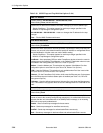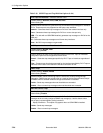
3. Configuration Options
3-96 December 2002 9000-A2-GB31-00
DLCI Traps on Interfaces – Interface Selection Field
Possible Settings: Network, Ports, DBM, All, None
Default Setting: All
Specifies which interfaces will generate linkUp and linkDown trap messages for individual
DLCIs. These traps are only supported on the frame relay interfaces.
Network – Generates these trap messages on DLCIs for the network interface only.
Ports – Generates these trap messages for DLCIs on a user data port only.
DBM – For units with an ISDN DBM installed, generates trap messages on DLCIs for the
DBM only.
All – Generates these trap messages on all frame relay interfaces.
None – No DLCI trap messages are generated.
DLCI Traps on Interfaces – Filter Selection Field
Possible Settings: Normal, Filter
Default Setting: Normal
Controls whether the traps on the interfaces specified in the DLCI Traps on Interfaces
configuration option are sent regardless of their cause.
Normal – Generates trap messages specified by DLCI Traps on Interfaces regardless of
cause.
Filter – Prevents traps from being generated for the interfaces specified by DLCI Traps on
Interfaces if their cause is the loss of the interface connection or LMI.
RMON Traps
Possible Settings: Enable, Disable
Default Setting: Enable
Specifies whether remote monitoring traps are sent to the currently configured trap
manager(s). RMON traps are typically sent as a result of the Alarms and Events Groups
of RMON1 when a selected variable’s configured threshold is exceeded.
Enable – Sends trap messages when set thresholds are exceeded.
Disable – Does not send trap messages when set thresholds are exceeded.
ISDN Dial Control Traps
Possible Settings: Enable, Disable
Default Setting: Disable
Controls whether dialCtlPeerCallSetup and dialCtlPeerCallInformation events send trap
messages to the currently configured SNMP trap manager(s). Use this feature when
peer-to-peer (nearest neighbor) calling is desired.
Display Conditions – This option only appears when an ISDN DBM is installed.
Enable – Sends trap messages.
Disable – Does not send trap messages.
Table 3-36. SNMP Traps and Trap Dial-Out Options (4 of 6)


















